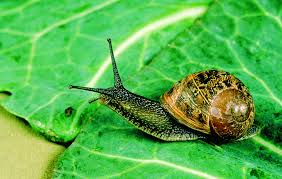Your Garden… with Sharon McCray: Now is the time to protect your garden from those nasty pests
Using rice hulls is a good way to manage water-logged areas in your garden.
![]()

Snails are garden pests.
By Sharon McCray

Sharon McCray
What a soggy, wet, windy and wild couple of weeks we have had. Trees are down everywhere and our gardens show the wear and tear. As I look out my window, I see bright yellow daffodils poking out all around and brilliant red amaryllis ready to pop! The season seems as confused as I do.
Mother Nature is sure full of surprises. But what is a befuddled gardener to do? It is too early for spring but we want sun and clear days. Warm nights would be an added bonus. Not allowing for Punxsutawney Phil’s observation, I am somewhat skeptical that Old Man Winter isn’t through with us yet.
It is time again to evaluate. Where are we now? What worked last year and what didn’t? Did that new variety of tomato you planted meet your expectations, or are you ready to return to your old reliable variety? My personal favorite is Ace tomato, so I planted about a dozen seeds in January, put them on a warming matt and am pleased to know that when the soil warms, the days lengthen and nights stay pleasant, I can plant those seedlings and once again recall the day my father introduced me to his personal favorite.
My advice, put on some warm clothes and rubber boots, if you have them, and step outside. What exactly is going on? Are the snails and slugs making their way to your lettuce and spinach? Are the earwigs raising havoc with everything else? Too cold for aphids but be on the lookout.
Because I have lived in Santa Clara County for a very long time, I know that spring arrives when I start finding spittlebugs on everything. Spittlebugs are those white clumps of foam that cling to most everything in the garden, but especially the soft leafy perennials just making their way out of dormancy.
The easiest way to manage spittlebugs is with a blast of water from your garden hose. Inside that clump of foam lives a tiny green insect with a main goal to suck the life out of your plants. Once on the ground, they cannot return to their perch and therefore, your problem is solved.
The other sucking pests, like snails and slugs, are just as easy to detect. Look for damage in the soft tissues of your tender plants.
I have found that coffee grounds are a good deterrent when placed on the soil surrounding affected plants. Research has shown that caffeine can be fatal to slugs and snails. The old tried and true method of a shallow dish filled with beer is also an option, but I say, why waste the beer when a spoon of bread yeast in a basin of water will accomplish the same result.
 Now as for those chewing insects such as earwigs, a tuna-size can filled two-thirds with soy sauce and a little cooking oil will attract them, where they will promptly dive in for a drink and die. A little gruesome but this method will not harm your pets or wild birds.
Now as for those chewing insects such as earwigs, a tuna-size can filled two-thirds with soy sauce and a little cooking oil will attract them, where they will promptly dive in for a drink and die. A little gruesome but this method will not harm your pets or wild birds.
Using rice hulls is a good way to manage water-logged areas in your garden. They can absorb a great deal of water as well as add organic material to your soil, a win-win in my book.
Make sure that those plants against your home and under eaves are getting their fair share of water as well. Hold off fertilizing anything until the soil and daytime temperatures warm. Most fertilizers won’t activate until then.
Sharon McCray is a California native living in Santa Clara County since 1959. She became certified as a University of California cooperative extension master gardener in 1992 and a UCCE master naturalist in 2015. She hosts a radio show on KKUP public radio and is now retired.
- Aging with Attitude … with Dorie Sugay: Annual fair provides a plethora of resources for seniors, families - May 3, 2024
- Women Leaders … with Kelly Barbazette: PJIFF’s panel focuses on bringing more women into the industry - May 3, 2024
- Your Retirement … with Marisa Otto: Do you know how your retirement income is going to be taxed? - May 3, 2024
